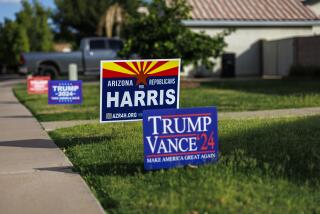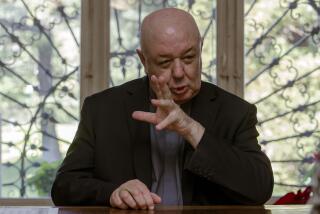Document Forgery Sharpens Debate on Mormon History
- Share via
BERKELEY — The conviction of rare Mormon documents dealer Mark W. Hofmann for murder and forgery in the Salt Lake City bombings case is forcing a showdown between the church hierarchy and Mormon researchers, speakers said at a conference of liberal members of the church.
According to two Salt Lake City authors investigating the Hofmann scam, he was not out just for financial gain: Hofmann had a thematic master plan to influence perceptions of Mormon history.
“Hofmann tried to develop certain topics . . . which were contrary to canonized or officially endorsed church histories,” Allen Roberts said in a keynote paper for the conference.
Roberts added that the attention Hofmann has focused on Mormon origins has sent church authorities scrambling to “close open questions” about the church’s beginnings in the 1830s.
Hofmann admitted that he forged the so-called White Salamander Letter, which was donated to the church, and that he sold for thousands of dollars a collection of documents purportly written by an early Mormon apostle who became disillusioned with the faith. But the collection apparently never existed.
As a result of complex plea bargaining that allowed Hofmann to avoid a trial, he pleaded guilty on Jan. 23 to two counts of theft by deception and two of second-degree murder--the pipe-bomb blasts that killed two people in October of 1985 to cover up his fraud and forgery scheme. He was sentenced to a term of five years to life in Utah State Prison.
The case has set off a spate of new research by sources both friendly and hostile to the 6-million-member Church of Jesus Christ of Latter-day Saints, according to researchers attending the scholarly Sunstone Foundation symposium held here last weekend.
The forum, the first to be held by Sunstone in California, was attended by 550 persons--nearly twice the number expected. The independent organization, which is not officially sanctioned by the Mormon Church, publishes a magazine with a circulation of about 6,000. Sunstone was founded in 1975 to provide “thoughtful and balanced scholarship and sensitive investigation” of Mormon theology and history, according to forum planner Lorie Winder Stromberg.
Roberts, an architect and a former president of the Sunstone Foundation, said that Hofmann, who was reared in a Mormon family and married in the Salt Lake City Temple, secretly became an atheist at about age 13 and wanted to let church “members know what the real Mormonism is all about.”
He thus produced the bogus documents in order to erode the veracity of official church teachings about its origin, discredit the role of Joseph Smith as the church’s “prime prophet” and founding father, and lend credence to anti-Mormon sources, Roberts suggested.
In a strange twist of the concept of truth, Hofmann thought his forged documents were “factual in content and filled in missing gaps,” Roberts said in an interview following his talk. Roberts and journalist Linda Sillitoe are writing a book investigating the sensational rise and fall of Mormonism’s most celebrated and controversial book dealer.
Roberts said that Hofmann “was trying to demythologize Mormon history and portray a more realistic and honest version of Joseph Smith and Mormon beginnings. . . . He felt that historians would validate the content (of his forgeries), which, in fact they did.”
“The irony is that Hofmann was not a believer in the man he came in some ways to resemble.”
In Roberts’ paper, “The New Mormon History--Mark Hofmann Style,” he said Hofmann’s revisionist agenda included attempts to portray Joseph Smith as a “money digger” who was caught up in folk magic and occult practices.
“At least six Hofmann documents promote the old anti-Mormon accusation that Smith was very involved in . . . treasure-seeking, an activity thought by many to be inconsistent with his role as God’s prophet and leader of the true church,” Roberts said.
The “White Salamander” letter, purportedly written by early Mormon disciple Martin Harris to W. W. Phelps in 1830, was Hofmann’s “most fertile document” and the greatest challenge to official Mormon teaching, according to Roberts. The church teaches that an angel named Moroni led Smith to golden plates which he translated into the Book of Mormon, the faith’s most sacred Scripture.
But the salamander letter--which Mormon authorities considered authentic when Hofmann first produced it--involved “a clever spirit” in the guise of a white salamander, a common folk-magic symbol of Smith’s time.
“Perhaps more than any other influence in the 1980s to date, this document has been the catalyst for concentrated study of 19th-Century folk religion, white magic and money digging,” Roberts said. “Many leading Mormon historians picked up the gauntlet thrown down by Hofmann.”
As a result, many Mormon historians acknowledge that some of Hofmann’s fictionalized material about Joseph Smith and the intertwining of folk magic and religion must now be recognized as an accurate backdrop for Mormon history.
At the same time, Sillitoe said, the Mormon headquarters is “enforcing traditional history.”
Meanwhile, church officials have recently imposed strict limitations on outsiders’ use of the church archives in Salt Lake City, where many Mormon historical writings are preserved, and closed the church presidential collections until further notice.
Mormon author David Beurger of Santa Clara, who presented a paper here, said he had been banned from the archives last summer after he wrote articles on sensitive topics based on research conducted there. Beurger showed a reporter a form that researchers must now sign in order to use the archives. The form requires them to submit all manuscripts to church authorities for scrutiny before publication.
“The form applies retroactively,” Beurger said, adding that as a result some historians now refuse to use the library for fear that all their future manuscripts must be submitted for review even though they completed the research before the restriction took effect.
Sillitoe said in her paper, “The Successful Marketing of the Holy Grail,” that the church’s restrictive history policies fueled another assumption that Hofmann further exaggerated: “The belief that church leaders would ‘grab and stash’ controversial historical documents, and then deny possession of them.”
The 32-year-old Hofmann was able to “fool so many for so long,” Sillitoe suggested, because of his “quiet demeanor, his evasive and often humble comments, his tentative attitude toward the document which allowed others to make the claims, and his suggestions of authentication procedures. . . . Mark’s image as smart, honest and lucky was well established.”
Other documents that Hofmann claimed to have located--including one supposedly long-lost collection of papers now thought to be non-existent--purportedly contained information about Smith’s polygamy and alleged adultery and drunkenness. Still other documents alluded to or produced by Hofmann suggested that it was not Joseph Smith, but his brother, Alvin Smith, who was the first founder and prophet of the Mormon Church.
Hofmann’s intention, Roberts said, may “not have been to elevate Alvin as much as demean Joseph Smith. The implication, if legitimate, would have been staggering: Joseph became prophet more or less by default. . . . His involvement in money digging and the occult would seem more natural given the possibility that Joseph may have been a pretender to the role of prophet.”
Mormon historians acknowledge that Hofmann’s forgeries will make church researchers more cautious about authenticating newly discovered documents.
Leonard Arrington, the official Mormon church historian from 1972 to 1982, said the 48 documents the church obtained from Hofmann “have served to make us study more carefully our early history, and that is a plus.”
But he added that because careful researchers do not jump to radical new interpretations on the basis of only a few documents, the papers will, in the long run, have little influence on the writing of Mormon history.
Roberts said he thinks that the implications of the Hofmann case may be more significant.
Hofmann “pushed to a head” the “sparring match between church history and those things church authorities expect members to believe on faith,” Roberts said in the interview.
“How long the church can maintain the upper hand in the faith-history battle is (now) a matter of conjecture. . . . Literal multitudes are researching, writing, looking for old documents and questioning comfortable truths. . . .
“Mark Hofmann accelerated the conflict but he didn’t end it.”
More to Read
Sign up for Essential California
The most important California stories and recommendations in your inbox every morning.
You may occasionally receive promotional content from the Los Angeles Times.













